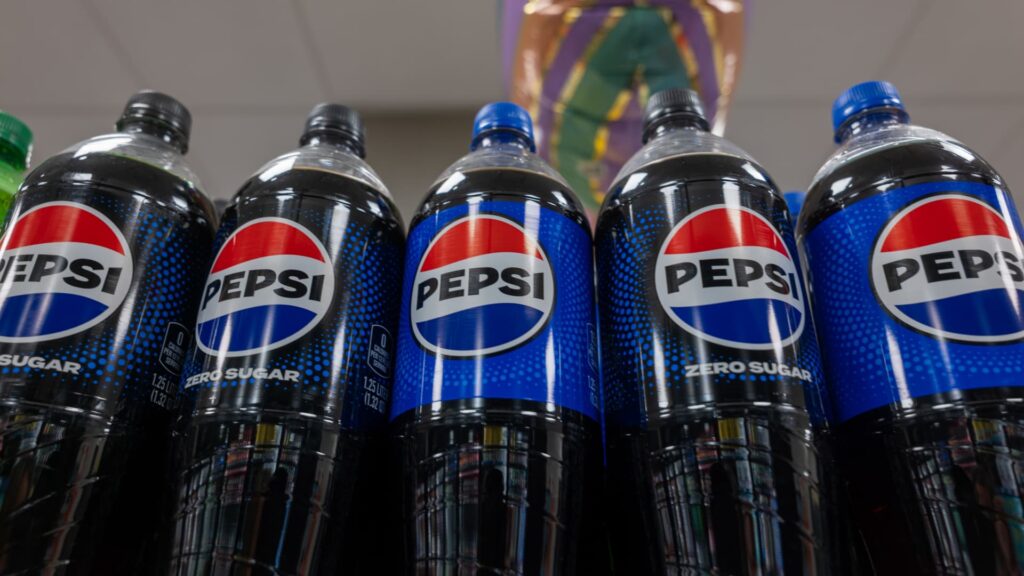
PepsiCo (PEP) Q1 2025 earnings
PepsiCo Q1 2025 Earnings: Mixed Results as International Growth Offsets North American Decline
PepsiCo headquarters as the company releases its Q1 2025 earnings report showing mixed financial results
PepsiCo Q1 2025 earnings report released Thursday revealed mixed quarterly results as the food and beverage giant navigates challenging economic conditions. The company reported that stronger international sales helped offset weaker demand in North America, while simultaneously announcing a revised forecast for core constant currency earnings per share amid growing economic concerns.
Table of Contents
- Key Financial Metrics from PepsiCo Q1 2025 Earnings
- North American Sales Challenges and Recovery Strategy
- Global Economic Factors Impacting Future Outlook
- Product Innovation and Portfolio Transformation
- FDA Regulatory Compliance and Natural Ingredients Transition
- Revised Financial Outlook for Fiscal Year 2025
Key Financial Metrics from PepsiCo Q1 2025 Earnings
The PepsiCo Q1 2025 earnings report highlighted several important financial metrics that paint a picture of the company’s current position. According to data shared with investors, PepsiCo reported first-quarter net income attributable to the company of $1.83 billion, or $1.33 per share, down from $2.04 billion, or $1.48 per share, compared to the same period last year.
| Metric | Actual | Expected (LSEG Analyst Survey) |
|---|---|---|
| Earnings Per Share (Adjusted) | $1.48 | $1.49 |
| Revenue | $17.92 billion | $17.77 billion |
| Net Sales Change | -1.8% | N/A |
| Organic Revenue Growth | +1.2% | N/A |
The company’s net sales dropped 1.8% to $17.92 billion, slightly exceeding analyst expectations of $17.77 billion. However, when excluding acquisitions, divestitures, and foreign currency effects, organic revenue showed modest growth of 1.2% for the quarter. This divergence between reported and organic revenue underscores the impact of external factors on PepsiCo’s financial performance.
Volume metrics from the PepsiCo Q1 2025 earnings report showed concerning trends in the company’s core business units. Worldwide volume fell 3% for PepsiCo’s convenient foods division, while beverage volume remained flat. These volume metrics, which exclude pricing and foreign exchange changes, provide insight into consumer demand patterns across PepsiCo’s diverse product portfolio.
North American Sales Challenges and Recovery Strategy
A significant highlight from the PepsiCo Q1 2025 earnings call was the company’s acknowledgment of challenges in its North American business. CEO Ramon Laguarta stated that the company is “taking actions” to improve performance in this critical market. Volume for PepsiCo’s domestic food business declined 1%, while its North American beverage unit experienced a more substantial volume decrease of 3%.
Consumer Behavior Insights
“Consumers have remained value‐conscious across brands and channels as the cumulative impacts of inflationary pressures have strained budgets and altered food shopping patterns,” explained Laguarta and CFO Jamie Caulfield in prepared remarks during the PepsiCo Q1 2025 earnings call.
To address these challenges, PepsiCo outlined a comprehensive strategy focused on expanding into high-growth segments. The company plans to further develop its multicultural and functional product lines, specifically highlighting its Simply, Sabra, and Siete brands as growth vehicles. This strategic pivot demonstrates PepsiCo’s commitment to adapting its portfolio to evolving consumer preferences.
The company’s recent acquisition of Poppi, a prebiotic soda brand, for more than $1.6 billion also features prominently in its North American recovery plan. This acquisition represents a strategic move to capitalize on growing consumer interest in functional beverages with health benefits, a segment experiencing rapid growth despite broader industry headwinds.
In response to the growing popularity of GLP-1 weight loss medications, which can affect appetite and food consumption patterns, PepsiCo also announced plans to add more protein to its portfolio. This proactive approach to addressing changing consumer needs demonstrates the company’s agility in responding to emerging health trends that could impact traditional snack and beverage consumption.
Global Economic Factors Impacting Future Outlook
The PepsiCo Q1 2025 earnings report highlighted several macroeconomic challenges that are influencing the company’s performance and outlook. CEO Ramon Laguarta addressed these concerns directly in his statement: “As we look ahead, we expect more volatility and uncertainty, particularly related to global trade developments, which we expect will increase our supply chain costs. At the same time, consumer conditions in many markets remain subdued and similarly have an uncertain outlook.”
Key External Challenges
- New tariffs impacting international trade and supply chain costs
- Economic volatility across key markets
- Increasingly cautious consumer spending behavior
- Ongoing inflationary pressures affecting purchasing power
These factors contributed to PepsiCo’s decision to cut its forecast for core constant currency earnings per share, a significant revision that sent shares of the company falling 2% in premarket trading following the PepsiCo Q1 2025 earnings announcement. The interconnected nature of these challenges presents a complex operating environment for the food and beverage giant as it navigates the remainder of fiscal year 2025.
While North American markets face particular headwinds, PepsiCo’s international operations provided a bright spot in the Q1 2025 earnings report. The company’s global diversification strategy appears to be providing some insulation against regional economic challenges, with international sales helping to offset domestic weakness.
Product Innovation and Portfolio Transformation
The PepsiCo Q1 2025 earnings presentation outlined several initiatives focused on product innovation and portfolio transformation. These strategic efforts aim to better position the company for changing market dynamics and evolving consumer preferences.
Despite the challenges in North America, the PepsiCo Q1 2025 earnings report highlighted several successful products that delivered positive results. Pepsi Zero Sugar helped the company gain market share in the competitive zero-calorie beverage segment. In the snack category, Miss Vickie’s chips and Quaker’s rice cakes were among the products that delivered net revenue growth, demonstrating that targeted innovation can drive performance even in challenging market conditions.
Portfolio Transformation Priorities
- Expanding multicultural and functional product offerings
- Strategic acquisitions like Poppi to access high-growth segments
- Adding more protein-rich options to address GLP-1 medication impacts
- Improving in-store product availability and placement
- Enhanced consumer engagement strategies
These initiatives underscore PepsiCo’s commitment to evolving its product portfolio to meet changing consumer demands while addressing the challenges identified in the Q1 2025 earnings report. By focusing on growth segments and adapting to emerging health trends, PepsiCo aims to strengthen its market position despite the near-term headwinds affecting the broader food and beverage industry.
FDA Regulatory Compliance and Natural Ingredients Transition
A significant development highlighted in the PepsiCo Q1 2025 earnings call was the company’s response to recent regulatory changes. Following the Food and Drug Administration’s announcement of plans to phase out synthetic dyes by the end of the year, Laguarta revealed that Lay’s and Tostito’s will eliminate artificial colors from their products by 2026.
The U.S. ban on petroleum-based colorants would impact several popular PepsiCo products, including Flamin’ Hot Cheetos and Mountain Dew Baja Blast. While it remains unclear what enforcement actions the FDA might take if companies don’t comply with its timeline, PepsiCo acknowledged that its overall transition will take longer than the FDA’s schedule. Currently, about 60% of PepsiCo’s products do not use artificial dyes.
CEO’s Statement on Natural Ingredients Transition
“In the next couple of years, we’ll have migrated all the portfolio into natural colors, or at least provide the consumer with natural color options, and obviously, every consumer will have the opportunity to choose what they prefer,” Laguarta stated during the PepsiCo Q1 2025 earnings call.
This transition represents both a challenge and an opportunity for PepsiCo. While reformulating popular products carries risks, successfully navigating this regulatory change could enhance brand perception among increasingly health-conscious consumers. The company’s approach of providing options rather than simply eliminating favorite products demonstrates a balanced strategy that acknowledges diverse consumer preferences.
Revised Financial Outlook for Fiscal Year 2025
Perhaps the most significant announcement from the PepsiCo Q1 2025 earnings report was the company’s revised financial guidance for the full fiscal year. PepsiCo now expects its core constant currency earnings per share to be roughly unchanged from the prior year, a substantial downward revision from its previous forecast that had projected mid-single-digit growth.
This guidance reduction reflects the cumulative impact of the challenges outlined throughout the earnings report, including North American sales weakness, global economic uncertainty, regulatory changes, and evolving consumer preferences. Despite these headwinds, PepsiCo maintained its outlook for organic revenue, still projecting a low-single-digit increase for the year.
Updated FY2025 Financial Guidance
| Metric | Previous Guidance | Updated Guidance |
|---|---|---|
| Core Constant Currency EPS Growth | Mid-single-digit growth | Roughly unchanged from FY2024 |
| Organic Revenue Growth | Low-single-digit increase | Low-single-digit increase (unchanged) |
The market’s immediate reaction to the PepsiCo Q1 2025 earnings report and revised guidance was negative, with shares falling 2% in premarket trading. This response highlights investor concerns about the company’s ability to navigate the challenging economic environment while maintaining profitability. However, PepsiCo’s continued commitment to organic revenue growth suggests that the company remains confident in its ability to drive top-line performance through its strategic initiatives and portfolio transformation efforts.
As PepsiCo moves forward in fiscal year 2025, the company’s ability to execute on its North American recovery strategy, successfully navigate regulatory changes, and leverage its international operations will be critical factors in determining whether it can meet or exceed these revised expectations. Despite the near-term challenges outlined in the Q1 2025 earnings report, PepsiCo’s diversified portfolio and strategic initiatives provide multiple pathways to potential recovery in subsequent quarters.






